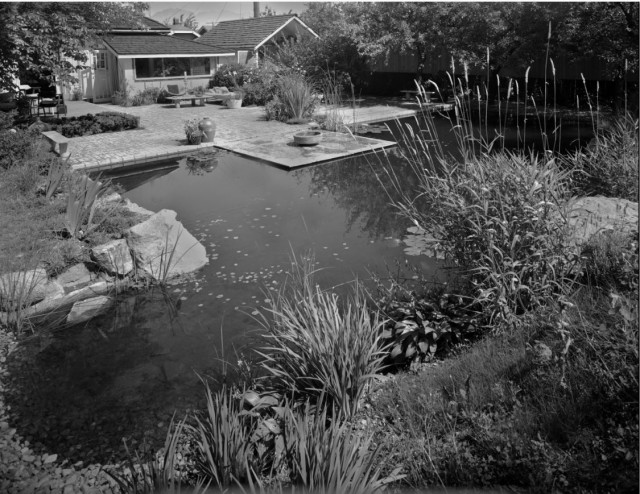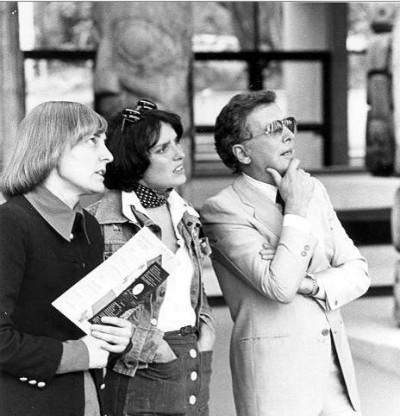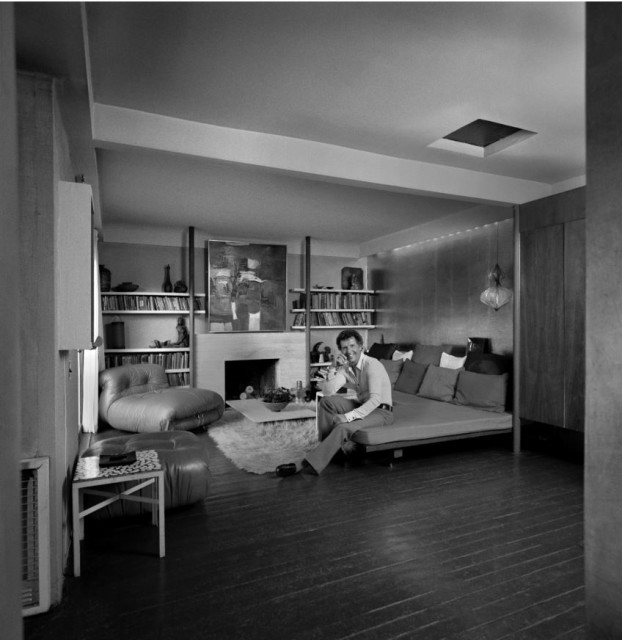Arthur Erickson is one of Canada’s most famous architects, yet his own house and garden ranks #8 on Heritage Vancouver’s top 10 endangered sites for 2014.

Arthur Erickson’s fingerprints are all over some of Metro Vancouver’s most iconic buildings—the Museum of Anthropology, Simon Fraser University and dozens of residential houses.
Unusual for an architect, Erickson chose not to design his own house, but bought a large corner lot in Point Grey with a 1924 cottage and garage for $11,000 out of which he created the 900-square-foot home where he lived for the next 52 years.
“Architecturally this house is terrible, but it serves as a refuge, a kind of decompression chamber,” he told author Edith Iglauer*.

He replaced the walls with sliding glass and connected the buildings, adding a bathroom and a kitchen. He played with different materials—leather tiles on the bathroom wall, wall tiles in Italian suede in the living room, and Thai silk in the study—and then he turned his attention to the garden.
Erickson bulldozed the English garden, dug a hole for the pond and used the dirt to make a hill high enough to block the view of his house from his neighbours.
“Everybody in the neighbourhood thought I was excavating to build a house, and chatted with me over the picket fence, very happy to believe that they were no longer going to have a nonconformist garage dweller among them,” he told Iglauer*.
He planted grasses and rushes from the Fraser River, pine trees from the forest, put in 10 different species of bamboo, and added rhododendrons, a dogwood, and a persimmon to the existing fruit trees. He was known for throwing lavish garden parties that drew a guest list ranging from Pierre Trudeau to Rudolf Nureyev
Barry Downs lived in the Dunbar area at the time and knew Erickson quite well.
“We both had little ponds full of fish and one day Mary and I gave him a turtle,” said Downs. “He phoned me up and said ‘get over here your turtle is eating my fish!’”
Down’s told him that was impossible, the turtle had a mouth the size of Erickson’s thumb.
“I went over and sure enough there’s a fish sticking out of its mouth,” said Downs, adding that yes he took the turtle back.
“Arthur was ruthless. He had a BB gun and would shoot at the herons that would come in and land and eat his fish. Once he told me that he shot through the neighbour’s window accidently,” says Downs.

Downs says the impressive Japanese-inspired marble terrace panels in the garden are the toilet stalls from the old Hotel Vancouver.
Erickson may have been a talented architect but he was hopeless with finances. By 1992 he had racked up over $10 million in debt and was on the verge of losing his house. A group of friends which included Peter Wall, who took over the $475,000 mortgage, placed the house and garden in the hands of the Arthur Erickson Foundation. Erickson lived there until his death in 2009.
*Iglauer, Edith. Seven Stones: A Portrait of Arthur Erickson, Architect. Harbour Publishing, 1981.
© All rights reserved. Unless otherwise indicated, all blog content copyright Eve Lazarus.




10 comments on “Arthur Erickson’s House and Garden are on the Endangered List”
Yet another example of how little we think of our architecture, and apparently the architects who create our heritage buildings.
There seems to be a kind of planned obsolescence built into the very fabric of our culture demanding the past be swept into the dustbin of history every few decades.
& yes. some of us have to move to or work in other places (Countries; Cities), to execute the energy we have & can’t release @ home
I helped prepare the reproductions for the book “Arthur Erickson, Architect” in 1975 while I worked as a cameraman at TR TRADES Reproductions on Fourth Ave. The book was printed in Japan using the plate negatives I developed by hand. I worked hand in hand with Simon Scott who did photography for Erickson. I later continued my reproductions career in Edmonton for several firms. Still doing large format photography and working on several books, one of which will document the world’s oldest living Limber Pine tree, growing for about 3000 years in Alberta’s Rockies near Abraham Lake. Not yet fully retired as I approach 80, I fondly remember working with the Erickson group and many other architect and engineering firms in Vancouver.
With love and gratitude…
What a great career! thanks for stopping by and not stoppin
[…] Binning wasn’t just an important artist; as a teacher, he influenced architects such as Arthur Erickson, Ron Thom and Fred Hollingsworth. His tiled murals are still outside the BC Hydro building (now the […]
[…] art deco building on West Georgia and the David Graham House in West Vancouver designed by Arthur Erickson in […]
[…] of Thompson Berwick Pratt, the firm that served as an incubator for such other up-and-comers as Arthur Erickson, Ron Thom, Barry Downs and Fred Hollingsworth and designed buildings such as the game-changing BC […]
[…] up by Ned Pratt who hired and mentored some of our most influential West Coast Modern architects. Arthur Erickson, Ron Thom, Paul Merrick, Barry Downs and Fred Hollingsworth all cut their teeth at TBP, and BC […]
[…] Arthur’s House and Garden are on the Endangered List […]
[…] pictures show Gordon Smith painting in the studio designed by Arthur Erickson; there’s a young Erickson lounging in his own adapted garage; and Jack Shadbolt is photographed […]